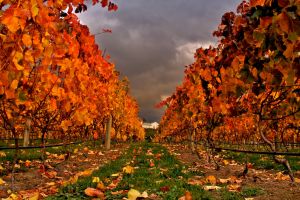Why is it red in America and yellow in Europe? A joint study by researchers from the University of Haifa and Finland goes back 35 million years during the joint evolution of plants and insects

Those who travel abroad in autumn cannot ignore the fall leaves that paint the trees in spectacular colors - in Europe the fall is usually yellow and in the United States and East Asia it is bright red. But why are there differences between the cast colors? A new theory by Prof. Simcha Lev-Yadon from the Biology Teaching Department of Haifa University in Oranim in collaboration with Prof. Jarmo Holopainen from the Finnish Kupio University published in the journal New Phytologist goes back 35 million years to solve the colorful mystery.
The green color of the tree leaves comes from the green pigment chlorophyll which is found in a higher percentage in the leaf compared to other pigments. The change of color to red or yellow with the arrival of autumn is not due to the "dying" process of the leaf, but rather to a combination of several processes that are different from the red autumn leaves to the yellow ones. In leaves that turn yellow, the green chlorophyll breaks down and disappears, therefore the yellow pigments already present in the leaf are accentuated and turn the leaf yellow. A different process takes place in red leaves. Simultaneously with the decomposition of chlorophyll there is a creation of the red pigment anthocyanin, which was not present in the leaf until now. These facts were discovered only recently and led to a burst of research to explain why the trees invest resources to produce red pigments near the fall of the leaves.
The explanations given for the phenomenon are different and there is still no consensus about them. One type of explanation claims that the production of the red pigment stems from physiological functions that optimize the recycling of amino acids in order to create protection from light and cold damage, and other explanations claim that these are different strategies for protection against insects that specialize in exploiting the flow of amino acids, but these explanations do not explain why in Europe this process is not Happening.
According to one of the ecological-evolutionary explanations, the reason for the bright shedding colors is the long-standing evolutionary war between the trees and the insects that eat their leaves - during the autumn period, which is the egg-laying period of these insects, the tree paints its leaves red or yellow to make the insects believe that it is chemically well protected . Even in this case the red color has a defensive logic, compared to the yellow which does not fit with this explanation, but at this point the new theory comes in.
According to the theory of Prof. Lev-Yadon and Prof. Holopainen, until 35 million years ago, considerable parts of the earth were covered with jungles and tropical forests of trees that did not sing their leaves at all. During this period, a series of ice ages and dry periods began and the trees began to become deciduous. Many of the deciduous trees began an evolutionary process to create red deciduous leaves to fight insects. In the region of North America, as well as in East Asia, mountain chains oriented from north to south created areas protected from the cooling of the ice ages and allowed the "migration" of plants and animals there and together with them their "enemies" the insects also migrated there and the war of survival was not interrupted. In Europe, on the other hand, the direction of the mountain ranges (the Alps and their spurs) is from east to west, so no protected areas were created. The trees that could not survive the intense cold died and with them the insects that lived on them. With the end of the ice ages, the tree species that managed to survive in Europe did not have to deal with the extinct insects and therefore no longer needed the effort of creating the red leaves.
According to the researchers, evidence of the validity of the theory can be found in dwarf shrubs that grow in Scandinavia, which still paint their leaves red in autumn. Unlike the large trees, the dwarf shrubs were able to survive the cold periods of ice and snow because, due to their small size, the snow cover that covers them in winter isolates them from the extreme conditions prevailing above the snow. Under the blanket of snow, the specific insects that feed on them are also protected, and so also in these types of bushes, the struggle with the insects continues, forcing them to paint their leaves red.

5 תגובות
There are mistakes in the article, for example, everyone knows that the color of the beech leaves in autumn: Fagus sylvatica, the tree that dominated the forests of Central Europe, like most of the deciduous ones from the oak family, is reddish-orange and this is despite what is written in the article. I expect more criticism.
For 4 so what, 5770 years ago the spirit rested on God and he decided to make his world colorful eh?! Otherwise he will get bored when the different sides of the country appear before him.. What can I say, the genius of religious fanaticism is amazing!
This is what was previously written on the subject
https://www.hayadan.org.il/exfoliation-271006/
https://www.hayadan.org.il/colors-of-falling-leaves-16110710/
https://www.hayadan.org.il/colors-of-falling-leaves-16110710/
https://www.hayadan.org.il/exfoliation-271006/
Amazing to me the thought process that makes it possible to reach an unknown point which is the destination, and then to be able to outline the way back, when on the way back the explanations become understandable and even requested.
(as opposed of course to shooting an arrow and then drawing the target around it)